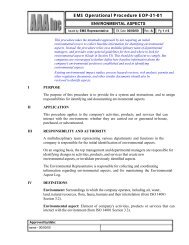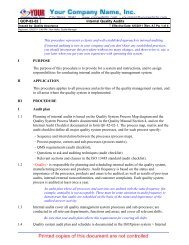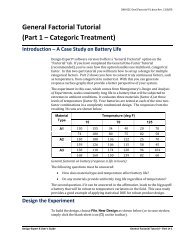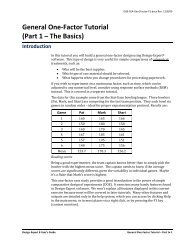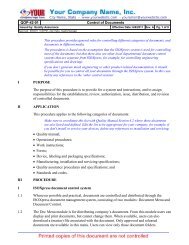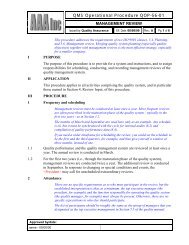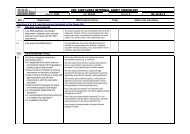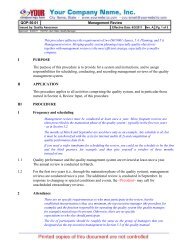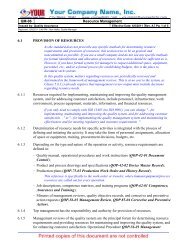Quality Manual QM-01 Scope - Quality Coach
Quality Manual QM-01 Scope - Quality Coach
Quality Manual QM-01 Scope - Quality Coach
- No tags were found...
Create successful ePaper yourself
Turn your PDF publications into a flip-book with our unique Google optimized e-Paper software.
<strong>QM</strong>-<strong>01</strong><strong>Scope</strong>Issued by: <strong>Quality</strong> Assurance Effective Date: 6/6/2<strong>01</strong>1 Rev. A Pg. 1 of 3Approved: 6/6/2<strong>01</strong>1 5:48 PM - Alan Halko, <strong>Quality</strong> Manager1.1 QUALITY POLICYQUALITY POLICY is committed to meeting customerrequirements and enhancing customer satisfactionthrough continual improvement of its products,services and the quality management system.This policy is too general, and it should not be considered as an example of a proper policy.It is included here only to illustrate how the policy could be presented in the manual.1.2 INTRODUCTIONThis section includes an introduction, a definition of operations and products to which thequality system applies, and statement of any exclusions of ISO 13485 requirements (perClause 1.2 of the standard).1.2.1 developed and implemented a quality management system to demonstrateits ability to consistently provide product that meets customer and regulatory requirements,and to address customer satisfaction through the effective application of the system,including continual improvement and the prevention of nonconformity.The introductory paragraph is taken from ISO 90<strong>01</strong>:2000 Section 1.1. If you don't need tocomply with ISO 90<strong>01</strong> and only with ISO 13485, delete the second part of the sentence thatrefers to customer satisfaction and continual improvement.1.2.2 The quality system complies with the international standard ISO 13485:2003.List any other standards with which your quality system complies, for example, ISO 90<strong>01</strong>,21 CFR Part 820 (FDA's QSR), other national regulations, etc..1.2.3 The manual is divided into eight sections modeled on the sectional organization of the ISO13485:2003 standard. Sections are further divided into several subsections representing mainquality system processes. Each subsection defines general policies and basic principles forthe pertinent quality system process; summarizes responsibilities and methods; andreferences relevant operational procedures and other documents.1.2.4 The purpose of this manual is to define and describe the quality system, to define authorities
<strong>QM</strong>-<strong>01</strong> <strong>Scope</strong> Rev. A Pg. 2 of 3and responsibilities of the management personnel involved in the operation of the system,and to provide a general description of all processes comprising the quality system.1.2.5 Another purpose of this manual is to present the quality system to customers, suppliers,regulators and other external interested parties, and to inform them what specific controls areimplemented at to assure quality.1.3 APPLICATIONDefine the products (medical devices) and services for which this quality system applies.Where applicable, in addition to manufacture and delivery you may add design,development, distribution, installation, servicing, etc., of the products. If you don't apply thesystem to all categories of products, name specifically these products to which the systemapplies. Here, you can also directly use the scope of your ISO 13485 certification.1.3.1 The quality management system defined in this manual applies to the design, manufactureand distribution of medical devices offered by .1.4 EXCLUSIONSInstead of "medical devices" name the products specifically (or generally by categories ortypes of products).This section pertains to ISO 13485 Clause 1.2, Application, allowing for claiming exclusionsfrom certain requirements of the standard. Under previous editions, organizations couldchoose between ISO 13485 and ISO 13488, depending on the nature of their operations andneeds. Now there is only one specification of requirements, ISO 13485, but organizationsmay claim exclusions from various requirements that do not apply to their operations.The intention is primarily to allow exclusions of design control requirements where thereare no design activities (old ISO 13488). But you can also exclude other requirements thatdon't apply, for example, 7.5.4, Customer property.Note that in some countries you may be able to exclude design control requirements evenwhen you design products. Contact your registrar or regulatory agency to find out if thiswould apply in your situation.This clause starts with a short procedure explaining briefly the rules for taking exclusions,who makes these determinations and who approves them, and how exclusions aredocumented. Although not explicitly required, the procedure helps to demonstrate that thereis a deliberate process for identifying applicable exclusions, and thus adds credibility to thevalidity of the claimed exclusions.1.4.1 The quality management system shall be relevant to the nature of our organization andproducts, and to customer and regulatory requirements. For this reason, those requirementsof ISO 13485 that do not apply are excluded from the scope of our quality system.1.4.2 An ISO 13485:2003 requirement may be excluded only when the following three conditionsare met:The following two conditions are identical to those stated in ISO 13485 Clause 1.2.· The requirement must be within ISO 13485 Clause 7, Product Realization;· The exclusion may not affect our ability, nor absolve us from the responsibility, to provideproduct that meets specified requirements; and
<strong>QM</strong>-<strong>01</strong> <strong>Scope</strong> Rev. A Pg. 3 of 3· The exclusion may not affect our ability to carry out corrective action.1.4.3 Processes which are applicable to the medical device(s), but which are performed by outsidecontractors, do not qualify for exclusion. They are accounted for in the quality system toensure control over such outsourced processes.1.4.4 The is responsible for identifying those requirements of ISO 13485 that donot apply to our organization or products, and to propose to the top management that suchrequirements be excluded from the scope of the quality system.1.4.5 Top management evaluates the proposed exclusions and determines whether they areappropriate. The evaluation and approval of exclusions are conducted within the frameworkof management reviews of the quality system (refer to Operational Procedure QOP-56-<strong>01</strong>,Management Review).Formal approval of exclusions by the top management is not explicitly required in thestandard. Thus, you may delete this paragraph if you feel that it is not appropriate, or doesnot apply in your company. I included it here because decisions regarding the scope of thequality system are often important enough to warrant direct involvement of the topmanagement, and because these decisions may have direct bearing on the compliance statusof the company.1.4.6 Any exclusions taken are documented in this section of the quality manual. The excludedrequirements are precisely identified with reference to specific clauses and/or statements inthe standard. There is also a brief justification why the exclusion is taken and why it isappropriate.CLAIMED EXCLUSIONSIf all requirements of ISO 13485 Section 7 apply, write here "No exclusions taken." You stillneed this section in the manual to define how exclusions will be identified, should thisbecome relevant in the future.If you identified any exclusions, document them as in the two examples below. The firstexample illustrates how an ISO 13488:1996 or ISO 9002:1994 company may justifyexclusion of design and development requirements. The second example may be relevant toa company that does not receive any products or documents from its customers.I. Exclusion: ISO 13485 (2003) Section 7.3, Design and Development, including allsubsectionsJustification: does not design or develop products. All principal productcharacteristics are specified by the customers or their consultants. Our engineering activitiesare limited to developing methods and means of production, fabrication, or installation.II.Exclusion: ISO 13485 (2003) Section 7.5.4, Customer PropertyJustification: does not receive from customers any tangible orintellectual property that is intended for incorporation into, or in any way associated with themedical device(s).
FOR MORE INFORMATION AND BUYING OPTIONSPlease follow the link below to learn more and purchase the template documentationISO 13485 FDA QSR (21 CFR 820) <strong>Quality</strong> <strong>Manual</strong> Templateshttp://www.qualitycoach.net/shop/shopexd.asp?id=5860



